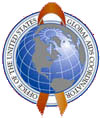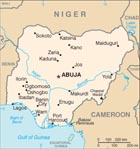|

Office of the United States Global AIDS Coordinator
Providing leadership, coordination and oversight to the unified U.S. Government effort to implement the President?s Emergency Plan for AIDS Relief
U.S. Department of State
U.S. Agency for International Development
U.S. Department of Defense
U.S. Department of Commerce
U.S. Department of Labor
U.S, Department of Health and Human
Services
Peace Corps
Mailing address:
SA-29, 2nd Floor
2201 C Street, NW Washington, DC 20522-2920
www.state.gov/s/gac
1. UNAIDS, Report of the Global AIDS Epidemic, 2004. |
 HIV/AIDS Situation in Nigeria HIV/AIDS Situation in Nigeria
HIV Infected: 3.6 million1
AIDS Deaths: 310,0001
AIDS Orphans: 1.8 million1
Many risk factors contribute to the HIV epidemic in Nigeria, including mobility of commercial sex workers (CSWs), polygamy, high-risk practices among itinerant workers, high prevalence of sexually transmitted infections (STIs), clandestine high-risk homosexual practices, international trafficking of women, and irregular blood screening. Youth and young adults in Nigeria are particularly vulnerable to HIV. Recent estimates from the 2003 National HIV/Syphilis Seroprevalence Sentinel Survey (2004) by the Federal Ministry of Health (FMOH) indicate an HIV prevalence rate of 5.4 percent for individuals aged 25 to 29; 5.6 percent for those aged 20 to 24, and 4 percent for those aged 15 to 19.
U.S. Government Response
The Nigerian government created the National AIDS Control and Prevention Program (NASCP) within the Federal Ministry of Health (FMOH) in 1987, a Presidential AIDS Commission (PAC) comprised of ministers from all sectors in 1999 and the National Action Committee on AIDS (NACA) based in the Office of the Presidency in 2000. The HIV/AIDS Emergency Action Plan (HEAP) developed in 2001 and revised in 2004 serves as the national action framework. |
|
Challenges to Emergency Plan Implementation
Nigeria is emerging from a period of military rule that accounted for almost 28 of the 44 years since independence in 1960. Consequently, the policy environment is not fully democratized. Civil society was weak during the military era, and its role in advocacy and lobbying remains weak. The size of the population and the nation pose logistical and political challenges particularly due to the political determination of the Nigerian government to achieve health care equity across geopolitical zones. The necessity to coordinate programs simultaneously at the federal, state and local level introduces complexity into planning. The large private sector is largely unregulated and, more importantly, has no formal connection to the public health system where most HIVinterventions are delivered. Training and human resource development is severely limited in all sectors and will hamper program implementation at all levels. Care and support is limited due to the fact that existing staff are overstretched and most have insufficient training in key technical areas to provide complete HIV services.
Emergency Plan Results
Number of individuals reached with community outreach HIV/AIDS prevention programs that promote Abstinence and Being Faithful: 5,873,900
Number of pregnant women receiving prevention of mother to child (PMTCT) services: 22,900
Number of pregnant women receiving antiretroviral prophylaxis: 600
Number of individuals receiving counseling and testing: 22,200
Number of HIV-infected individuals who received palliative care/basic health care and support: 39,700
Number of Orphans and Vulnerable Children (OVCs) who were served by an OVC program: 4,100
Number of individuals receiving upstream system strengthening support for treatment:1 5,200
Number of individuals receiving downstream site-specific support for treatment:2 8,300
Prevention and care results reflect accomplishments through September 2004 and combine upstream and downstream support. Treatment results reflect accomplishments through March 2005.
1. Number of individuals reached through upstream systems strengthening includes those supported through contributions to support national strategies through national, regional, and local activities such as training, laboratory support, monitoring and evaluation, logistics
and distribution systems, protocol and curriculum development.
2. umber of individuals reached through downstream site-specific support includes those receiving treatment where the Emergency Plan supports programs at the point of service delivery. |
The activities of the U.S. President?s Emergency Plan for AIDS Relief (the Emergency Plan) are carried out in close collaboration with Nigerian authorities including NACA and FMOH. These activities include:
- Enlisting popular support and political will for HIV/AIDS prevention, treatment and care activities and policies;
- Developing the capacity of nongovernmental organizations (NGOs) and government agencies; national, regional, state and local organizations with numerous chapters or branches reaching down to the grassroots level;
- Adopting new indigenous partners in strategically-selected high-prevalence states;
- Integrating Voluntary HIV Counseling and Testing (VCT) and antiretroviral treatment (ART) into the National Tuberculosis (TB) Control Program;
- Establishing a regional training laboratory dedicated to providing training on VCT/ART for TB laboratory technicians;
- Establishing a system to stratify laboratories using standardized criteria and a quality assured network of laboratories.
Recognizing the global HIV/AIDS pandemic as one of the greatest health challenges of our time, President George W. Bush announced the Emergency Plan in 2003 ? the largest international health initiative by one nation, in history, to address a single disease. Under the leadership of the U.S. Global AIDS Coordinator, U.S. Government (USG) agencies implement the Emergency Plan, working collaboratively as an interagency country team under the direction of the U.S. Ambassador to Nigeria. This multidimensional team leverages partnerships with host governments, multilateral institutions, NGOs and the private sector to implement effective programs for combating HIV/AIDS and ensure efficient use of USG resources.
Nigeria is one of 15 focus countries of the Emergency Plan which collectively represent at least 50 percent of HIV infections worldwide. Under the Emergency Plan, Nigeria received more than $70.9 million in FY2004 to support a comprehensive HIV/AIDS prevention, treatment and care program. In 2005, the U.S. is committing an additional $113.4 million to support Nigeria?s fight against HIV/AIDS.
Emergency Plan Achievements in Nigeria
Critical Interventions for HIV/AIDS Prevention
- A significant number of new infections could be averted through ensuring a clean and safe blood supply. To address this, the USG provides technical assistance to the Safe Blood for Africa Foundation. Funding is also provided to the FMOH to provide services and care.
- Nigeria has very few physicians trained in the prevention of mother-to-child HIV transmission (PMTCT). To address this problem the USG has supported training for dozens of physicians in PMTCT. These physicians have in turn shared their knowledge through workshops for other prenatal health care workers.
- The USG also directly supports the Government of Nigeria to carry out the 2005 HIV/Syphilis Seroprevalence Surveillance Survey. This survey seeks participants among women attending antenatal clinics and select at-risk populations. Support is provided through technical assistance, test kits and medical supplies.
Critical Interventions for HIV/AIDS Care
- Many people living with HIV/AIDS (PLWHA) are left with little support from family, friends or the community, where in many cases they are ostracized. To alleviate gaps in the social safety net, the USG supports NGOs that provide home-based care and support groups for PLWHA.
- Due to the large number of children who have been orphaned by AIDS, the USG supports the Center for Development and Population Activities (CEDPA) to implement the Orphans and Vulnerable Children project. These efforts help to keep children in school who otherwise would be unable to attend. Through CEPDA, the USG has reached close to 600,000 PLWHA.
Critical Interventions for HIV/AIDS Treatment
- Using the network model, the USG is implementing treatment programs in eight states of the Nigerian federation and the Federal Capital Territory. ART points of service include university teaching hospitals, general hospitals and missionary hospitals.
- Doctors, nurses, laboratory technicians, counselors and other health care workers have been trained to deliver services.
- Thirteen laboratories have been renovated, expanded and equipped.
|



